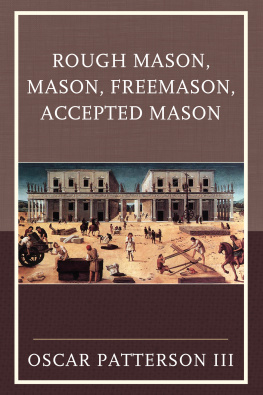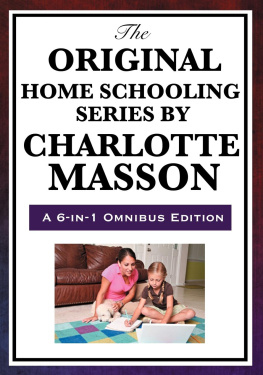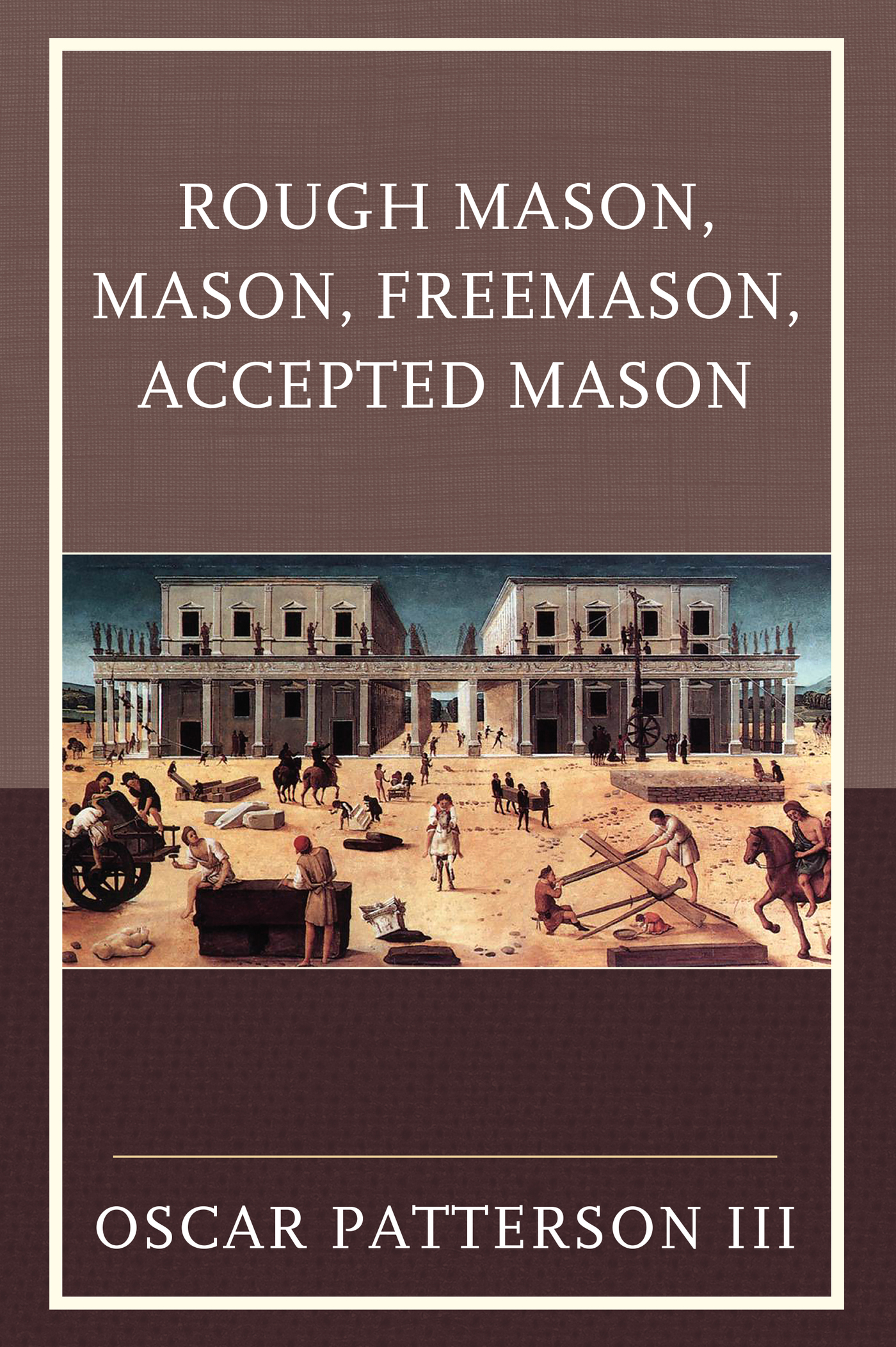Rough Mason, Mason, Freemason, Accepted Mason
Oscar Patterson III
Hamilton Books
Lanham Boulder New York Toronto Plymouth, UK
Copyright 2017 by Hamilton Books
4501 Forbes Boulevard, Suite 200, Lanham, Maryland 20706
Hamilton Books Acquisitions Department (301) 459-3366
Unit A, Whitacre Mews, 26-34 Stannary Street,
London SE11 4AB, United Kingdom
All rights reserved
Printed in the United States of America
British Library Cataloguing in Publication Information Available
Library of Congress Control Number: 2017944075
ISBN: 978-0-7618-6960-3 (pbk : alk. paper)ISBN: 978-0-7618-6961-0 (electronic)
Cover Art: The Building of a Palace by Piero di Cosimo (1462-1522) is an allegory of the art of building that was created between 1515 and 1520. It was commissioned by the Arte dei Maestri di Pietre e di Legname (Masters of Stone and Wood) in Florence and owned by the Medici family. It is considered by scholars to be an accurate representation of the construction of an idealized Renaissance palace. It is now on exhibit in the John and Mable Ringling Museum of Art in Sarasota, Florida.
 TM The paper used in this publication meets the minimum requirements of American National Standard for Information Sciences Permanence of Paper for Printed Library Materials, ANSI/NISO Z39.48-1992.
TM The paper used in this publication meets the minimum requirements of American National Standard for Information Sciences Permanence of Paper for Printed Library Materials, ANSI/NISO Z39.48-1992.
In Memory of James S. Davis
Comrade in Arms, Americal Division, Vietnam
Worshipful Master, Ashlar Lodge No. 98 2013
Mentor
Friend
Brother
Acknowledgments
This manuscript began several years ago as I undertook to research the history of Freemasonry. There is in existence in the modern world such an organization, but where and when did began and how it came into its present form are open to question. Libraries are replete with books that attempt to explain the organization. But as I read, I became disenchanted with what I found. This fueled my quest. There had to be more to the story than the myths and fables that were and are so prevalent.
I wish to express my sincere appreciation to Robert P. Harry, Jr., Past Grand Master of Masons of Florida for reading the manuscript and providing critical editing and suggestions. Most Worshipful Harry has been my mentor and guide throughout my Masonic life and I am so very grateful to have him leading my steps and being my friend.
Edward R. Suart, Past District Deputy Grand Master and Historian at Ashlar Lodge No. 98 in St. Augustine provided me with many valuable manuscripts and articles. He reviewed the text in-depth and made essential comments and grammatical corrections.
David Pierucci has sat on my left as Secretary and, more importantly, has been a good friend and Masonic Mentor. His input is invaluable and sincerely appreciated. He is also a member of Hope Lodge 2813 in Savanna La Mar, Jamaica and graciously introduced me to his Jamaican Brothers and the English Constitution Freemasonry. He read the manuscript while sitting at his mountain-top retreat in that tropical nation.
To my Brothers throughout Masonry, especially those at Ashlar Lodge No. 98, I offer my deepest appreciation. You took me in; made me part of your Great Fraternity; and encouraged me to achieve far beyond what I thought possible when I began my Masonic journey. You also encouraged my Masonic research and writing by obtaining copies of my book Interpreting Masonic Ritual and reading my articles published in various Masonic journals. To you I offer my deepest gratitude. You encouraged me to seek further knowledge and to share what I had learned.
Above all, to my wife, Julie, my soul-mate and best friendand too often a Masonic Widow I offer my sincerest appreciation for your support and encouragement. If not for a visit you made in, I may never have sought the privileges of Freemasonry. Your tour of the Grand Lodge of Pennsylvanias magnificent building led you to return with me in tow. You then encouraged me to seek membership and have supported me whole-heartedly as I moved through the chairs, served as a District Committeeman and State Chairman, and sat in the East. You attended one installation on our twenty-fifth wedding anniversary and graciously allowed me to miss your birthday another year to accept an Honorary Membership. You have ridden with me at the county fair and been at my side for installations and banquets. To you goes my eternal love and affection. Forever and always.
Introduction
Every person, organization, government, and nation had a beginning. Freemasonry is no different. Yet no organization comes to be as it is in a vacuum. History is a massive web of interrelated events and an understanding of the fact requires some level of mastery of research methodology and specialized knowledge.
Historians are part of a guild as surely as were ancient masons. Both groups focused their attention on creating strong foundations and preparing others to follow in their lead. There is in history no isolated, single, true tradition. History is collaboration as surely as is that of the construction of any magnificent edifice and involves discourse as well as the exchange of ideas. History also requires constant reassessment and it is anti-historical to be overly obsessed with a single point of view of the past.
The study of history is about getting the story relatively straight. Theories abound, but they must be tested and retested as new evidence is discovered and old evidence disproved. Essential to an understanding of history is context. It is inescapable that history happens within the context of a given time, set of attitudes, perspectives, and laws. To overlook this is to subvert the outcome of any historical analysis.
To understand the history of a group or organization requires thinking about the time and placed of origination as well as the people involved. Just as we have cultural awareness, we so too should have historical awareness. A principal venue for the historical record is the law. And while culture, those phenomena that seem to hold us together, may give us clues to understand history, it is through the political expression of the law that the official record survives. The law is the essence which provides continuity and predictability.
Throughout mans time on earth, fabulists and myth-makers provided their accounts of history in a quest to provide points of origin for then existing practices and privileges. What they did was, for them, historical, cultural, and political. Their work was often heavily influenced and highly constrained by sovereign powers which included church and state as well as available resources.
The study of history is also the study of literature. It is a matter of fixing the texts in their historical context and coming to grasp with the diversity as well as the polarity of meanings and readings. History does not yet provide a unified or general theory of the past. It is too full of complexity and permutations. To come to an understanding of the past, it is necessary for the historian to become familiar with his predecessors as well as his contemporaries, and to take into consideration those who live through and wrote about each age: what motivated them and what their audience took both to and from these histories as well what those audiences expected of the histories being produced.
Finally, a historian should endeavor to come to grasps with the nature of human variation which produces in its wake widely divergent interpretations of any given set of facts. This is essential to understanding the legitimate intent and designated meaning of the author.








 TM The paper used in this publication meets the minimum requirements of American National Standard for Information Sciences Permanence of Paper for Printed Library Materials, ANSI/NISO Z39.48-1992.
TM The paper used in this publication meets the minimum requirements of American National Standard for Information Sciences Permanence of Paper for Printed Library Materials, ANSI/NISO Z39.48-1992.